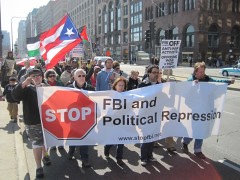
Committee Against FBI Repression contingent at the Chicago anti-war demonstration held on March 19 commemorating the 8th anniversary of the U.S. imperialist occupation of Iraq. Demonstrations took place across the U.S. , a photo by Pan-African News Wire File Photos on Flickr.
Local NATO hosts red-faced over ‘Red Zone’ militarization plan
BY FRAN SPIELMAN
City Hall Reporter/fspielman@suntimes.com
Last Modified: Apr 26, 2012 09:24PM
The head of Chicago’s NATO Host Committee said Thursday she was blindsided by the federal government’s decision to create a militarized “Red Zone” in the Loop to protect federal buildings in the run-up to the May 20-21 summit at McCormick Place.
The image of federal agents on downtown streets far from McCormick Place — in battle gear, weapons slung — three weeks before the summit is certain to have a chilling effect on those who live and work in the Loop. It also calls into question Host Committee Executive Director Lori Healey’s oft-repeated message that Chicago will remain “open for business” during the summit.
On Thursday, Healey found herself in the difficult position of having to convince the public that a scary headline that blindsided even her is not an indication that the feds are bracing for weeks of trouble.
“A lot of us were surprised to read that. Obviously, the federal government doesn’t consult with the city when they do this. Everybody was unaware of this,” she said.
“It’s common practice for the federal government to have protection around their own buildings. Everybody plans extensively … for lots of different events. This is just getting an undue amount of attention. I would guarantee you they do it for all sorts of events. It’s just that they decided to publicly release it.”
Asked whether Mayor Rahm Emanuel was also blindsided by the Red Zone decision, City Hall offered a one-line response.
“This was a security decision and we were not involved,” the mayor’s communications director Sarah Hamilton wrote in an email to the Sun-Times.
The Chicago Sun-Times reported this week that the plan for “Operation Red Zone” kicks into high gear next week to protect a vast area in the Loop where thousands of federal employees and dozens of government offices are located.
The Federal Protective Service will deploy additional personnel beginning May 1, bringing in more people from out of town and outfitting them in “battle dress uniform.” They will be carrying “non-lethal” long guns — bean bag weapons — in a show of force that at the same time will allow people to move in and out of the zone freely, federal employees were told.
Healey called the news “a little bit distracting,” but not alarming. She stressed that the protective bubble was being created by the “landlord” for government buildings — not by the intelligence arm of the federal government.
The U.S. Secret Service plans to release its logistics plan — including specific boundaries of the security perimeter around McCormick Place — next week, she said. That’s when all the speculation about the inconvenience to everyday life in Chicago will finally be put to rest.
“Let’s keep in mind that the summit itself is 24-hours. It starts on a Sunday. There’s not a lot of business people down working on Sunday. Monday, there’ll be some impact. But obviously, the city will put out the best way to get to and from downtown on that day after the [Secret] Service releases their plan,” Healey said.
“For us, the city is open for business. We’re happy to have … all these people coming to Chicago to experience our city. We think it’s a great opportunity.”
NATO Ambassador Kolinda Grabar offered the same message after a “classroom-to-classroom” video exchange — of musical selections and questions — between students at Kelly High School and the Afghanistan National Institute of Music.
“Some of the disadvantages — little uncomfortable things — will be very, very short-term. But, the advantages of the summit will be long-term for Chicago,” Grabar said.
“It is an opportunity to promote Chicago as a wonderful and beautiful city. … A lot more people will be attracted to come back to Chicago and to contribute to the local economy.”
Andy Thayer, a spokesman for the Coalition Against NATO-G-8, accused the federal government of creating the Red Zone to send a “message of intimidation” to protesters expected to descend on Chicago for the summit.
“It’s reminiscent of what happened prior to the Trans-Atlantic Business Dialogue, when the city got all Rambo-ed up as a way of scaring people from exercising their First Amendment rights,” Thayer said.
“If security measures are necessary, there are ways to go about it rather than getting hyper-militarized in a very visible way. It does nothing to stop any violence, but it does send a message of intimidation. This is a political show. It’s not about security.”
Despite the unsettling image of uniformed federal agents on the streets of Chicago, Thayer said his message to protesters is the same as it was after Mayor Rahm Emanuel rammed through his “sit-down-and-shut-up” ordinance to reign in the demonstrators.
“Don’t allow the city or the feds to intimidate you from exercising your freedom. It’s your right to be on the streets of Chicago on May 20,” Thayer said.
In fact, Thayer said it’s all the more reason to protest, adding, “If people are resentful of the militarization of our streets, just think how people in 130 countries around the world feel about U.S. troops in their countries.”
No comments:
Post a Comment